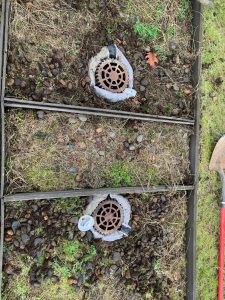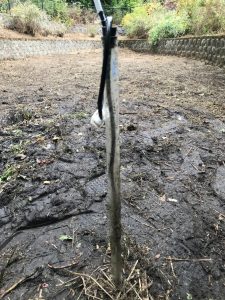Evaluation of a Green Roof Rehabilitation Method using Water Treatment Residuals
Nick Kanno
 Green roofs help control stormwater runoff through plant uptake and storage in the soil media. Water treatment residuals (WTRs) are used to reduce the solubility of phosphorus by binding with them in soils. WTRs are a by-product of water treatment plants after coagulation and flocculation. WTRs are clay particles with high concentrations of aluminum or iron and help remove small particles to produce clean drinking water.
Green roofs help control stormwater runoff through plant uptake and storage in the soil media. Water treatment residuals (WTRs) are used to reduce the solubility of phosphorus by binding with them in soils. WTRs are a by-product of water treatment plants after coagulation and flocculation. WTRs are clay particles with high concentrations of aluminum or iron and help remove small particles to produce clean drinking water.
Phosphorus is leaching from the green roof which could potentially cause algal blooms in receiving waters. WTRs may help reduce leaching and provide a solution to this problem. This study considered how the use of WTRs located at the drain of a green roof would affect the total phosphorus (TP), phosphate (PO₄³⁻), copper (Cu), and zinc (Zn) levels compared to a roof runoff
Impact of Bioretention Age and Type on Water Quality
Troy Membrere & Jared Miyasato
Bioretention has become a frequently used best management practice to mitigate urban stormwater runoff. However, there is insufficient research on the impact of aging on bioretention systems. Urban stormwater runoff transports large volumes of pollutants to surrounding bodies of water. Specifically, when excess phosphorus is introduced into bodies of water, they can produce algal blooms. While bioretention systems are a viable solution to treating urban stormwater runoff, there are developing issues regarding residual leaching that occurs within the bioretention soil mixture.
 To further understand the impact of bioretention systems on urban stormwater runoff, analysis on older and younger bioretention systems is necessary. This study compares the removal efficiency of five different bioretention systems at the University of Portland. To collect samples, lysimeters have been installed at all five stormwater management systems at the University of Portland. Samples are being collected over a year during heavy rain events. Samples were analyzed for orthophosphate as P, total phosphorous, zinc, and copper. It can be hypothesized that newer bioretention systems will have higher levels of metals and nutrients, and will decrease with age.
To further understand the impact of bioretention systems on urban stormwater runoff, analysis on older and younger bioretention systems is necessary. This study compares the removal efficiency of five different bioretention systems at the University of Portland. To collect samples, lysimeters have been installed at all five stormwater management systems at the University of Portland. Samples are being collected over a year during heavy rain events. Samples were analyzed for orthophosphate as P, total phosphorous, zinc, and copper. It can be hypothesized that newer bioretention systems will have higher levels of metals and nutrients, and will decrease with age.
Hydrology Apparatus
Jose Bastida De Jesus, Katie Conkle, Jenna Kube and Mustaf Mohamed
There is often little hands on work done by students to demonstrate the different factors that can affect the direction, speed and volume of runoff from storm events. These hydrology apparati were designed and constructed to enable a lab where students would be able to design their own scenarios using different materials and apparatus set up to study the changes in runoff. The materials vary from gravel to astro turf to bath mats (representing rocks, vegetation and impervious urban areas respectively) to many other options to allow students to simulate different landscapes. The apparati can also be set to different slopes and the amount of “rain” can also be controlled. The goal of this lab is for students to construct a unit hydrograph for each scenario they create using the amount of runoff and compare the results. This lab will increase students understanding of the impact vegetation and development have on runoff by helping them visualize the dramatic changes the different environments can cause.